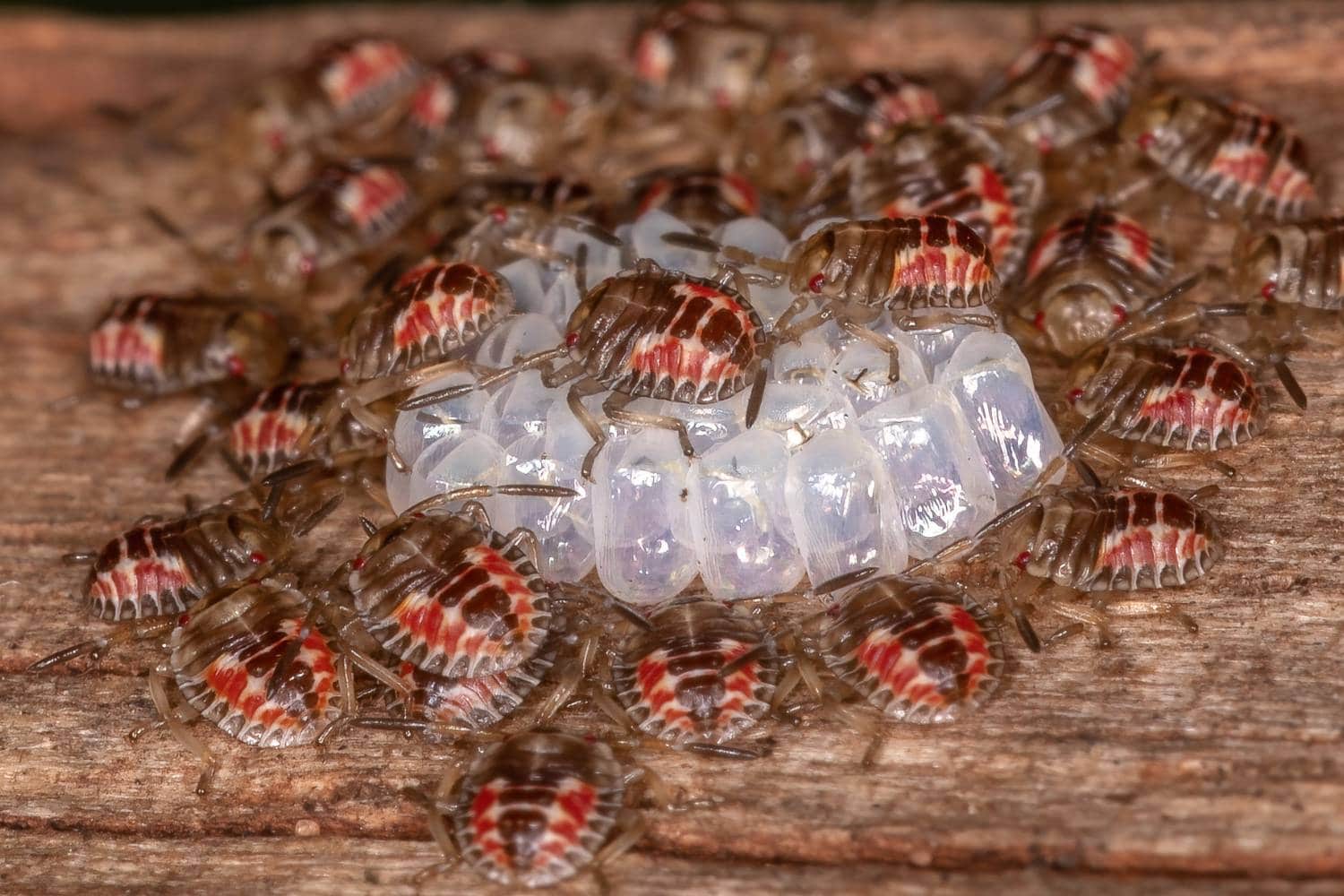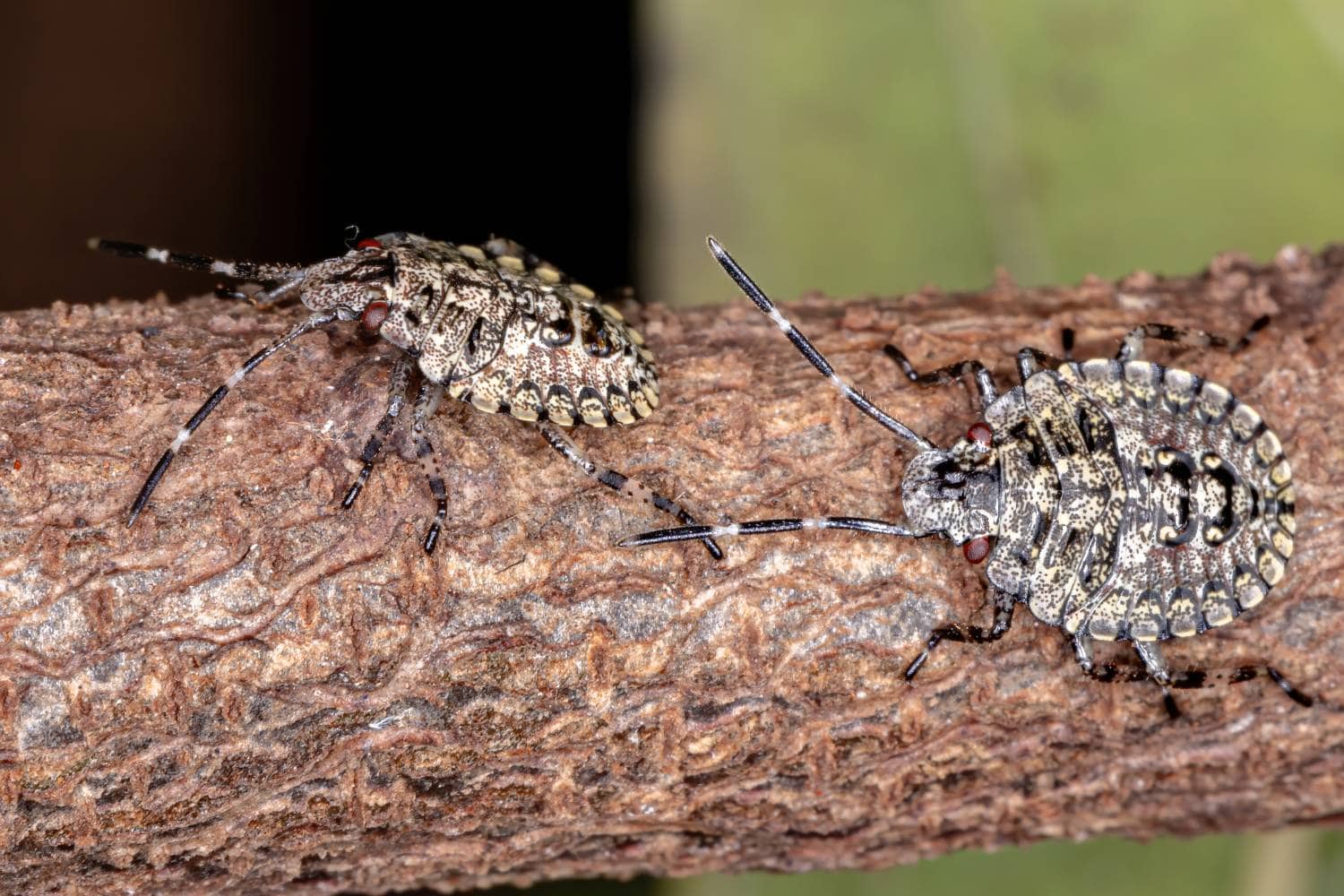Stink bugs are unwelcome guests in many Australian homes, especially as the weather cools down.
These pests, infamous for their unpleasant odour when disturbed, seek warmth and shelter, often finding their way inside through small crevices. While stink bugs don’t bite or pose health risks to humans, they can be a nuisance.
If you’re struggling with stink bugs, there’s no need to worry – there are effective ways to tackle the issue. Read on to learn how to get rid of stink bugs and prevent them from returning.
Let’s get straight to the point
Stink bugs invade homes seeking warmth during cooler months and can be a nuisance due to their foul smell when disturbed. They don’t bite or harm humans but can cause agricultural damage.
To get rid of them, natural repellents like mint or neem oil sprays, diatomaceous earth, and soapy water traps are effective.
Prevention includes sealing entry points, fixing screens, using dehumidifiers, and reducing outdoor lighting.
Professional pest control may be needed for large infestations. Regular maintenance and preventive measures can help keep stink bugs at bay.

Why Do Stink Bugs Invade Our Homes?
The Lifecycle of Stink Bugs
Stink bugs are most active in the warmer months, where they thrive outdoors, feeding on fruits, vegetables, and other plants.
As autumn approaches, they begin looking for warm places to hibernate during the winter.
This is when stink bugs commonly invade homes. Once inside, they stay dormant in walls, attics, and other hidden areas until the warmer spring months.
Stink Bugs in Australia
Australia is home to various stink bug species, but the brown marmorated stink bug is the most notorious.
Originating from Asia, this pest has established itself in multiple regions, including Australia.
Not only are they a menace in homes, but they are also a significant threat to agriculture, feeding on crops like apples, grapes, and peaches.
How to Identify a Stink Bug Infestation
Spotting the Signs
If you’re noticing an increase in small, shield-shaped bugs around your home, particularly near windows, walls, or in attics, you may be dealing with a stink bug infestation.
These pests emit a distinctive smell when disturbed, so a strong, unpleasant odour can also indicate their presence.
Why Stink Bugs Smell
Stink bugs get their name from the foul-smelling odour they release when threatened.
This smell comes from chemicals they produce to ward off predators. Crushing them only intensifies the smell, so it’s best to use alternative methods to remove them.
How to Get Rid of Stink Bugs
Use Essential Oils
A natural, effective way to repel stink bugs is to use essential oils. Stink bugs dislike strong scents such as mint.
Mix 10 drops of mint essential oil with 16 ounces of water and spray this solution around entry points, such as doors and windows.
Neem Oil Solution
Another natural solution involves neem oil, which disrupts the bug’s life cycle.
Mix two teaspoons of neem oil with 32 ounces of water and spray it around areas where stink bugs enter your home, such as cracks and windowsills.
Neem oil works slowly, so you may need to reapply it over time.
Diatomaceous Earth
For a more hands-off approach, you can use diatomaceous earth, a natural powder that kills stink bugs by dehydrating them. Sprinkle it around areas where stink bugs are likely to enter your home, such as doorways and window frames.
Soapy Water Trap
A simple method to kill stink bugs is by using a soapy water trap. Fill a container with soapy water and place it under areas where stink bugs are present. When disturbed, stink bugs often fall, and the soapy water will trap and drown them.
Fly Tape
Sticky fly tape can also be used to trap stink bugs. Hang it near windows or other entry points. While not the most attractive solution, it’s effective at catching and killing pests.
Preventing Stink Bugs from Entering
Seal Entry Points
The best way to deal with stink bugs is to prevent them from entering your home in the first place.
Seal all cracks and crevices around your house, particularly in areas where walls meet windows, doors, and siding. Use high-quality silicone caulk to seal gaps around windows and doors.
Fix Screens and Weather Stripping
Ensure all window and door screens are intact and free from holes. Replace damaged screens immediately, as stink bugs can squeeze through even the smallest openings. Check the weather stripping around doors and windows and replace it if necessary.
Use a Dehumidifier
Stink bugs are attracted to moisture, so reducing humidity in your home can help deter them. Using a dehumidifier in damp areas like basements or garages can make your home less inviting to stink bugs.
Reduce Outdoor Lighting
Stink bugs are attracted to light, so try to reduce outdoor lighting during the evenings. Turn off porch lights and close blinds or curtains to prevent them from being drawn to your home.
Homemade Remedies to Repel Stink Bugs
Garlic Spray
Stink bugs dislike the smell of garlic, making it a great natural repellent. Mix four teaspoons of garlic powder with two cups of water and spray it around windows and doors to prevent stink bugs from entering.
Nicotine Spray
For those who don’t mind using stronger measures, a nicotine spray can be effective. Soak cigarette butts in water overnight, strain the liquid, and mix it with a small amount of dish soap.
Spray this mixture on stink bugs to kill them. However, use this method cautiously, as nicotine is toxic.
Dryer Sheets
Some homeowners have found success by rubbing dryer sheets on window screens and door frames. The scent is unpleasant to stink bugs, and it can prevent them from settling in these areas.

When to Call a Professional
Handling Large Infestations
While DIY methods can work for smaller infestations, sometimes stink bugs can invade in large numbers, making it difficult to manage on your own.
If you find hundreds or thousands of stink bugs in your home, it’s time to call a professional pest control service.
They will not only remove the pests but also provide tips on how to prevent future infestations.
Frequently Asked Questions
Do Stink Bugs Bite?
No, stink bugs do not bite or pose any danger to humans. However, they can be a nuisance due to their foul smell and tendency to invade homes in large numbers.
Are Stink Bugs Harmful to Pets?
Stink bugs are generally not harmful to pets, but if a dog or cat ingests one, it may experience mild discomfort, such as drooling or vomiting, due to the bug’s unpleasant taste and smell.
What Time of Year Are Stink Bugs Most Active?
Stink bugs are most active in spring and autumn. In autumn, they seek warm places to hibernate, and in spring, they emerge from hiding to return outdoors.
Conclusion
Stink bugs can be persistent pests, but with the right prevention methods and removal techniques, you can keep your home stink-bug-free.
Sealing cracks, reducing moisture, and using natural repellents are the first steps toward solving the problem. If the infestation becomes too large, don’t hesitate to seek professional assistance.
By taking proactive measures, you can avoid the unpleasant smell and nuisance of stink bugs in your home.
Frequently Asked Questions
What Exactly Is It About Our Homes That Draw Stink Bugs?
During the colder months, stink bugs seek shelter inside a home to keep warm while they are dormant.
If it’s too difficult for them to get inside, they’ll move on to an easier target. Stink bugs release a pheromone when they have found a suitable habitat, attracting more of their kind to the area.
What Causes Stink Bug Infestations, And How Can They Be Prevented?
Capture-and-release operation: stink bugs are drawn to bright lights. You can trap them in a bottle or jar and throw them away or put them in the trash after sealing them up.
Spray the pesticide outside only. Using pesticides inside won’t stop more insects from getting in.
How About Stink Bugs? Do They Have A Chance To Lay Their Eggs Inside?
The good news is that stink bug eggs are rarely discovered inside buildings. Stink bugs typically lay their eggs in the spring when the weather is mild.
These pests may seek refuge indoors as the weather outside gets colder, but you can rest assured that they won’t be laying eggs there.
What Exactly Is It About Our Homes That Draw Stink Bugs?
During the colder months, stink bugs seek shelter inside a home to keep warm while they are dormant.
If it’s too difficult for them to get inside, they’ll move on to an easier target.
Stink bugs release a pheromone when they have found a suitable habitat, attracting more of their kind to the area.
What Causes Stink Bug Infestations, And How Can They Be Prevented?
Capture-and-release operation: stink bugs are drawn to bright lights. You can trap them in a bottle or jar and throw them away or put them in the trash after sealing them up.
Spray the pesticide outside only. Using pesticides inside won’t stop more insects from getting in.

